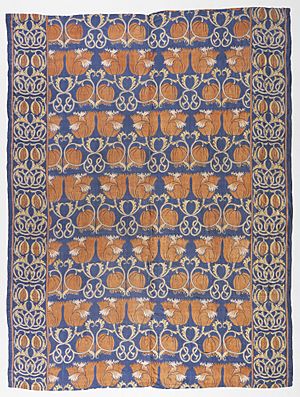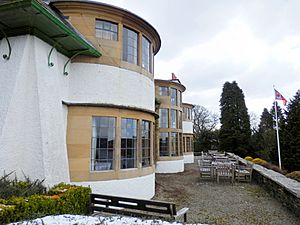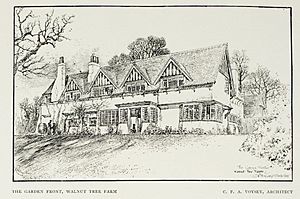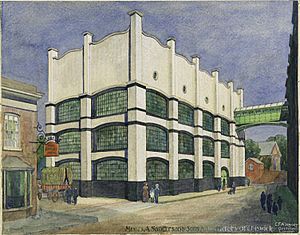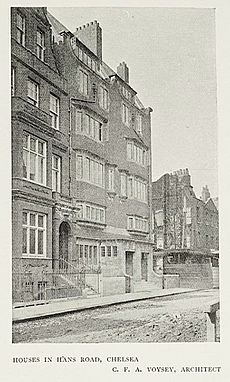C. F. A. Voysey facts for kids
Quick facts for kids
Charles Francis Annesley Voysey
|
|
|---|---|
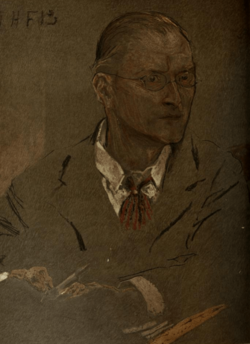
Voysey in 1901
|
|
| Born | 28 May 1857 Hessle, Yorkshire, England
|
| Died | 12 February 1941 (aged 83) Winchester, England
|
| Nationality | English |
| Occupation | Architect |
| Awards | RSA Royal Designers for Industry, 1938 RIBA Gold Medal, 1940 |
| Buildings | Broad Leys, Windermere, Cumbria (1898) Norney Grange, nr Shackleford, Surrey (1897) Perrycroft, Colwall, Malvern (1893–94) The Whitwood Institute, Whitwood, Castleford (1904) |
| Design | designer of textiles and furniture |
Charles Francis Annesley Voysey (born May 28, 1857 – died February 12, 1941) was a famous English architect. He also designed furniture and fabrics. Voysey started by creating designs for wallpapers, fabrics, and home items. His style was part of the Arts and Crafts Movement. He also helped shape the Modern Style (British Art Nouveau style) in Britain. A well-known magazine called The Studio recognized his talent. He is most famous for designing many beautiful country houses.
Voysey was one of the first to see how important industrial design would become. Some people even see him as a pioneer of Modern Architecture. However, he didn't agree with this idea himself. His English house designs were inspired by traditional local styles. They were not based on formal school teachings. He was influenced by the ideas of Herbert Tudor Buckland and Augustus Pugin.
The Sanderson wallpaper factory in Chiswick was designed by Voysey in 1901. It is now called Voysey House in his honor.
Contents
Becoming an Architect and Designer
Charles Francis Annesley Voysey was born in Hessle, Yorkshire, on May 28, 1857. He was the oldest son of Charles Voysey, a Church of England priest. His father lost his job in 1871 because of his unusual religious views. After this, his family moved to London. There, his father started a new church called the Theistic Church. Voysey was taught by his father at home. He also briefly attended Dulwich College.
In 1874, Voysey began training with architect J. P. Seddon for five years. He then stayed on for another year as Seddon's main helper. From Seddon, Voysey learned important design rules. These rules, first shared by A. W. N. Pugin, said that buildings should be designed from the inside out. They also taught that only honest, simple building methods should be used. Both Seddon and Voysey believed in these rules. They didn't just copy old Gothic styles. Seddon's buildings still looked a bit Gothic. But Voysey's later work had no old styles at all. Voysey also believed, like Pugin, that architects should design more than just buildings. They should also design things like furniture.
In 1879, Voysey worked briefly for architect Henry Saxon Snell. From 1880 to 1881, he worked for George Devey. Devey followed his father's Theistic Church. Working with Devey, Voysey learned a lot about building on site. He also saw Devey's talent for painting and his knowledge of traditional English buildings. In 1881 or early 1882, Voysey opened his own design business in London.
Voysey's Unique Designs
Voysey designed many everyday objects. These included furniture, wallpapers, fabrics, carpets, tiles, metalwork, ceramics, and graphic designs. Sometimes, he created items just for his own buildings. Other times, he sold his designs to companies for them to make and sell widely.
Voysey's furniture design style grew as he became a better architect. By about 1895, he had developed his own clear style. Most of his furniture followed this style until 1910. After that, he started adding more details, like Gothic patterns. The simple beauty of Voysey's furniture from 1895 to 1910 came from using good quality materials. He especially liked unpolished oak. He avoided fancy decorations. Instead, he focused on a careful balance of up-and-down and side-to-side lines in his designs.
He often made the vertical parts stand out. He would make the corner supports thinner from a square to an eight-sided shape. He also made them taller than needed. The horizontal parts were often highlighted by simple molded tops. He also used round caps on top of corner supports. This idea came from Arthur Heygate Mackmurdo. Long, unpolished bronze hinges also made the horizontal lines stand out.
Voysey was a great designer of flat patterns for wallpapers, fabrics, carpets, and tiles. Mackmurdo first taught him how to design wallpaper. Some of Voysey's early patterns used simpler versions of the swirling shapes Mackmurdo loved. Voysey sold his first wallpaper design in 1883. By the late 1880s, he was well-known for his wallpaper designs in Britain and other countries. He was still selling patterns in 1930. So, his career as a pattern designer was longer and more active than his architecture career. It also helped him financially. Selling patterns gave him money during the slow times in his architecture business, before 1895 and after 1910.
Many of Voysey's patterns used contrasting shapes. These shapes had flat, clear colors, usually with dark or light outlines. This style was like oriental designs that Victorian reformers admired. These reformers included Owen Jones and Matthew Digby Wyatt. In Voysey's work, simplified natural shapes, like plants and birds, were often the main shapes. The background areas formed the contrasting negative shapes. He also used this skill when designing metalwork, like grilles and hinges. Some of Voysey's patterns after 1900 had designs placed alone against a light background. The size of the patterns was often unusual. This gave them a simple, charming look, like medieval drawings and tapestries. His later designs were generally smaller and had softer colors than his designs from the 1880s and 1890s.
In 1883, Voysey started designing wallpapers for Jeffrey & Co. This was suggested by his friend A. H. Mackmurdo. He did this while waiting for architecture jobs. He joined the Art-Workers' Guild in 1884. He showed his printed fabrics and wallpapers at the first Arts and Crafts Exhibition Society show in 1888. In 1893, he began designing wallpapers for Essex & Co. He created hundreds of patterns for them.
Voysey's wallpaper and fabric designs changed over time. His earliest works, until the late 1880s, had traditional patterns influenced by history. By the mid-1890s, he was making his most unique designs. These were flowing patterns with soft colors. They featured flat shapes of birds, flowers, and hearts. The designs were used for both wallpaper and fabrics. These fabrics were often wool double cloths used for furniture.
Examples of his patterns from this time include The Saladin wallpaper (1897) and The Owl woven wool fabric (1898). After 1910, his patterns became more like stories. They had single pictures and were often made for children's rooms. The Alice in Wonderland fabric from around 1920 is a good example of this phase. His last known wallpaper job was in 1930.
In 1896, The Studio magazine praised Voysey's place in design. They wrote that "a 'Voysey wall-paper' sounds almost as familiar as a 'Morris chintz' or a 'Liberty silk'." Voysey also designed for Donegal Carpets and many other companies. He worked in design for fifty years.
Voysey's Architectural Work
Voysey's first design was for a house in Loughton. It was for Octavius Dixie Deacon. A house was built there, but we don't know if it looked like Voysey's design. By 1894, Voysey had moved his office to Melina Place, St John's Wood, London. His office was next door to Edward Schroeder Prior, another important Arts and Crafts architect. This led to a long friendship and sharing of ideas between them.
Voysey's architecture business started slowly. He did small changes and surveys. Many of his early designs were never built. But they were published and show the influence of Seddon and Devey. In 1888, he got his first architecture job. It was for The Cottage in Bishop's Itchington, Warwicks. Voysey added to it in 1900. The Cottage was built with thin, supported brickwork. It was covered in rough plaster and painted cream.
Voysey chose this building method because it was cheap. But he made it beautiful. He skillfully placed solid parts and empty spaces, light and shadow, in the clean shapes. Other architects in the 1800s, like Devey, built simple country cottages. These were for farm workers, priests, and teachers. They used white rough plaster. But The Cottage, built in 1888, was special. It was completely covered in rough plaster. It was also very simple and informal. This was revolutionary for a gentleman's house.
Walnut Tree Farm (1890) in Castlemorton, near Malvern, and a house in Bedford Park (1891), Chiswick, have new features that became typical of Voysey's designs. Walnut Tree Farm shows the lively colors that would become famous in his houses. It had white rough plaster, bright green outside wood, very large bright green water barrels, bright green tubs of bay trees, and bright red curtains. At Bedford Park, he used very simple classical details. It had a slate roof, and practical metal window frames with stone surrounds.
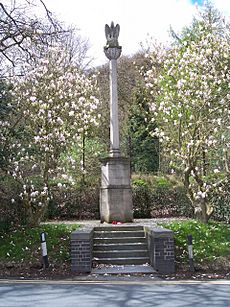
In 1893, Voysey got his first job for a more expensive house. This was Perrycroft, in Colwall, near Malvern. From then until 1910, Voysey had many architecture jobs. Most were simple, white country or suburban houses. They had low, wide shapes, which made him famous. He added some unique classical details to two expensive houses in Surrey, designed in 1897. These were New Place, near Haslemere, and Norney Grange, near Shackleford. But he returned to simplicity at Broad Leys and Moorcrag. These were lakeside houses near Windermere that he designed in 1898.
Between 1900 and 1910, Voysey got jobs where he could design entire houses. This included every detail inside. He designed not just built-in features, but also movable furniture, carpets, curtains, and wall coverings. The Orchard, in Chorleywood, Hertfordshire, was the first such house. He designed it for himself and his wife in 1899. In 1901, he designed The Pastures in North Luffenham, Rutland. In 1905, he designed Holly Mount, near Beaconsfield, and The Homestead in Frinton-on-Sea, Essex.
An interior design he did in London was Garden Corner (1906) on the Chelsea Embankment. In a typical Voysey interior, the low ceilings and deep borders were white. The woodwork was unpolished oak, if possible. Or it was cheaper deal wood, painted white. Colors in furniture, tiled fireplaces, and wall and floor coverings were soft and light. For example, he used delicate greens and purples, with a few bright touches of red and turquoise. A Voysey interior was not cluttered. Furniture was minimal. He used patterns sparingly in wallpapers, carpets, and metalwork.
After about 1910, Voysey's architecture business slowed down. This was mainly because he didn't like the new fashion for classical styles. He reacted by adding Gothic details to his work. In 1909, he used a pointed arch in the porch of Brooke End in Henley-in-Arden, Warwickshire. In the same year, he built a small house with a courtyard in the Tudor Gothic style. This was at Combe Down, near Bath. Designs from 1914 for larger houses were never built. They had unusual courtyard plans, pointed arches, castle-like tops, and towers.
Voysey only sometimes got jobs for buildings other than country or suburban houses. But when he did, he showed great skill. For his Bedford Park house, which had a small site, he didn't use his usual wide layout. Instead, he built a "tower house." The two brick-faced terrace houses (1891) he built in Hans Road, Knightsbridge, London, show clever planning. The Sanderson wallpaper factory (1902) in Chiswick is very practical in its shape. It is covered with white-glazed bricks. However, for the offices of the Essex and Suffolk Equitable Insurance Company (designed 1906–9), he felt that some expensive decoration was right. This was at Capel House, New Broad Street, London.
Voysey designed every detail of his houses, including the furniture. His houses were inspired by English traditional buildings from the 1500s and early 1600s. They had white roughcast walls with long, horizontal windows. They also had huge sloped roofs. He used rough plaster, slate, and other materials typical of English farmhouses.
Some examples of his finished architectural works are:
- Perrycroft, Colwall, Herefordshire (1893)
- Annesley Lodge, Hampstead, London (1896)
- An artist's cottage (14 South Parade), Chiswick, London (around 1890)
- Merlshanger (later Greyfriars), Hog's Back, Puttenham near Guildford (1896)
- Norney Grange, Shackleford (1897)
- Spade House, Sandgate, Kent (the home of writer H.G. Wells)
- Voysey House (a Sanderson wallpaper factory, now offices), Chiswick (1902)
- The Pastures, North Luffenham, Rutland (1903)
- The Orchard, Chorleywood (1900), which he designed for himself
- Voysey Garden, Emslie Horniman's Pleasance, North Kensington (1914), is a public garden designed by Voysey.
- Voysey designed the Malvern Wells War Memorial in Malvern Wells, Worcestershire. It was revealed in 1920 and has a sculpture of a pelican on top.
There are several examples of Voysey's designs near Bowness-on-Windermere, Cumbria. They have roughcast walls and large, plastered chimneys on sweeping slate roofs. The architectural historian Nikolaus Pevsner really liked The Orchard. He said Broad Leys was Voysey's best work. Pevsner saw in them the beginnings of the modern architecture movement.
Even though they were very different in theory, the simplicity and horizontal look of Voysey's houses were wrongly seen as early examples of the International Style. Because of this weak connection, Voysey received the RIBA Gold Medal in 1940.
However, Voysey himself, who was Master of the Art-Workers Guild in 1924, really disliked modern architecture. He was annoyed that Pevsner linked his work to that movement.
Broad Leys (1898–1900) is now the main building for the Windermere Motor Boat Racing Club. It was also in the movie The French Lieutenant's Woman. It is the only Voysey house where the public can stay.
Voysey passed away in Winchester in 1941.
Voysey's Lasting Impact
Voysey was influenced by William Morris, the Arts and Crafts Movement, and Art Nouveau. He cared more about how things looked and worked than about complex decorations. He believed that "simple decoration is one of the most important qualities for true richness." He often used a limited range of colors. He focused on outlines, removed shading, and kept details to a minimum. He joined the Art Workers' Guild in 1884. This group was the "conscientious core of the Arts and Crafts Movement." He was elected as its Master in 1924.
His furniture designs were simple and useful. They had very little decoration. He especially thought that wood should be left with its natural look. This was different from the popular methods of covering wood with paint and stain. He avoided the complicated styles of late Victorian design.
Many modest houses built in Britain in the 1920s and 1930s were inspired by Voysey's simple country houses. Even though Voysey himself didn't build any houses after 1918, his style lived on.
The Victoria and Albert Museum has a large collection of Voysey's work. This includes his design drawings, fabrics, carpets, and wallpapers. Architects influenced by Voysey include Jan Kotera, a leading Czech architect.
In 2011, the C. F. A. Voysey Society was formed. It is dedicated to his life and work.
See also
- Herbert Tudor Buckland
- Charles Cowles-Voysey


